Microsoft Cloud for Healthcare: Architect Perspective
Microsoft has launched Microsoft Cloud for Healthcare (MCFH), explicitly designed to tackle the challenges faced by the healthcare industry.
Join the DZone community and get the full member experience.
Join For FreeThe COVID-19 pandemic has impacted not just every aspect of people’s lives but every aspect of the healthcare system. It’s preventing healthcare delivery practices from operating at normal business levels, disrupting patient access to high-quality medical care, and forcing everyone to think about how to continue pushing forward in new and different ways.
As a result of the pandemic, the healthcare industry has seen a massive transformation. In this post-digital world, healthcare occupies a unique position. The industry has realized that digital must be integrated into all aspects of its operations since there is no longer any distinction between digital and non-digital media. Moreover, consumers are now driving the change in healthcare. There has been a massive shift in their needs. People increasingly demand healthcare on their terms, from leveraging data to identify their meal preferences to getting those meals exactly when they want them, to even delivering information to the proper channels. Digital can now support healthcare delivery based on preferences to patients — when, how, and where they want it.
This shift in patients’ demands is accelerating the need for more patient-centric care across geographies and socioeconomic groups. And this is driving industry stakeholders to transform the transactional nature of health care into a holistic human experience. And the urgency for this transformation has never been greater.
To support these human needs, Microsoft has launched Microsoft Cloud for Healthcare (MCFH), explicitly designed to tackle the challenges faced by the healthcare industry. MCFH aims to empower the healthcare industry to respond quicker, adapt to change faster, and build for the future while keeping security at its core.
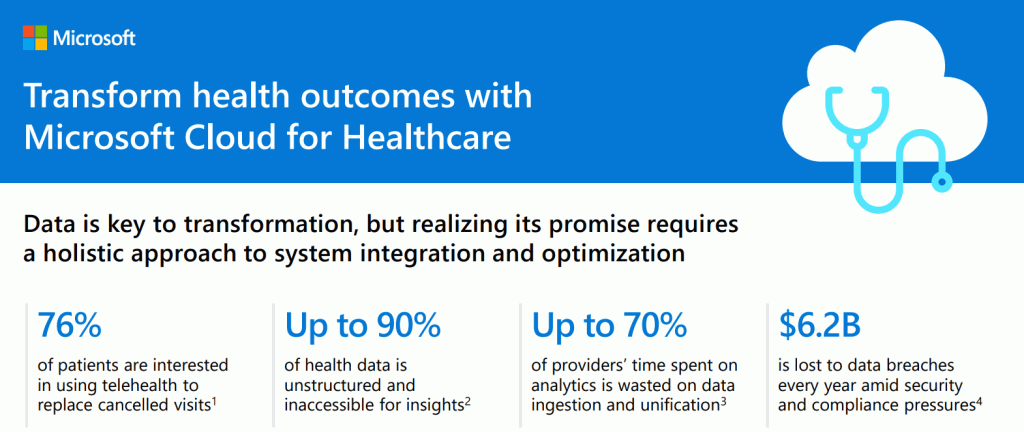
Before we dive deep into Microsoft Cloud for Healthcare, let’s look at the recent Healthcare trends to understand better how healthcare organizations can architect the future and rebuild the healthcare system.
Healthcare Trends in 2021

Accenture conducted a global survey of healthcare executives across six countries to identify five emerging healthcare trends that companies need to address to accelerate growth and profit.
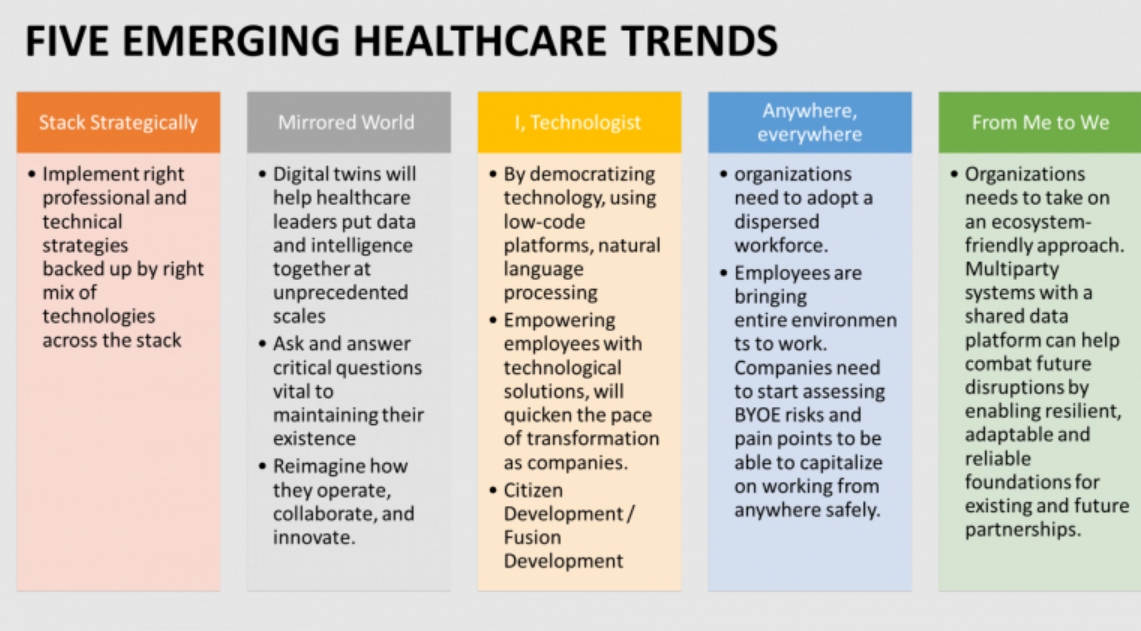
Cloud Imperative in the Healthcare Industry
Although healthcare organizations have been dabbling with cloud-enabled technologies before the pandemic, it is only after the world came to a standstill that companies adopted the cloud as part of their infrastructure. But this is just the beginning. Companies need to adopt a cloud-first mindset and hybrid cloud environment to tackle challenges faced by the industry.
Why Should the Healthcare Industry Adopt Cloud Services?
For starters, the Cloud enables multiple organizations within the healthcare industry to work together on data and effectively for drug and vaccine research, preventive maintenance and optimized usage of healthcare equipment, clinical trials, patient care, healthcare services planning, innovation in remote patient care, monitoring, and regulatory compliance. In addition, the adoption of cloud would also enable healthcare organizations with:
- Faster time market
- Quality healthcare services
- Operation excellence
- Boundary-less information sharing
- Intelligent automation and process optimization
- Cost saving (at scale can deliver 20–40% savings)
- Regulatory compliance
- Resilient supply chain ecosystem
Microsoft Cloud for Healthcare (MCFH)
Overview
Microsoft Cloud for Healthcare (MCFH) offers trusted, integrated capabilities that help organizations automate and streamline workflows while also enabling them to turn insights into action using a wide range of data analysis capabilities on both structured and unstructured data.

Microsoft has reimagined the healthcare system by creating a cloud service that brings together standard data models, cross-cloud connectors, workflows, APIs, and industry-specific components and standards, with the entire range of Microsoft’s cloud services, including Microsoft 365 and Teams, Azure, Microsoft Power Platform, Dynamics 365 and security solutions.
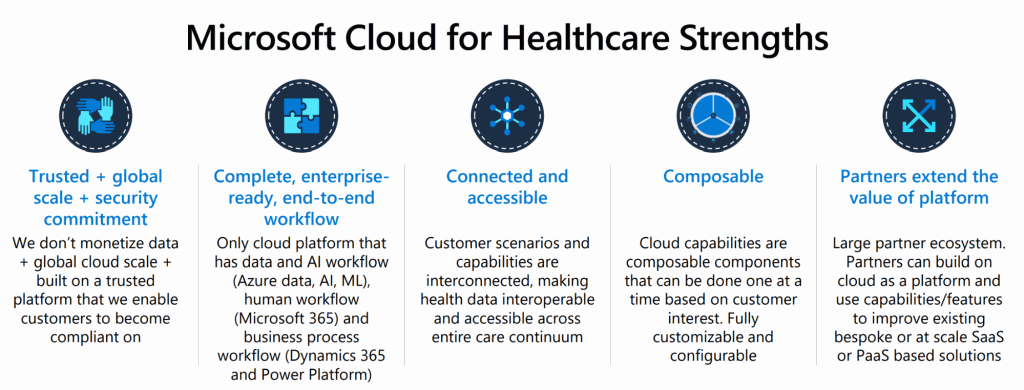
Architecture
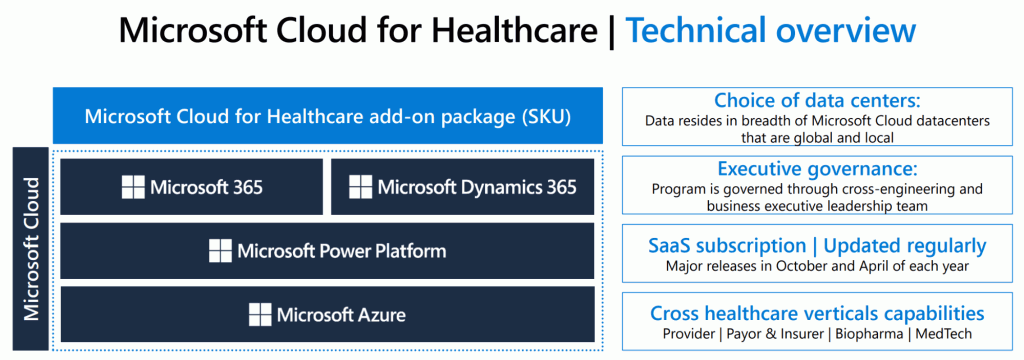
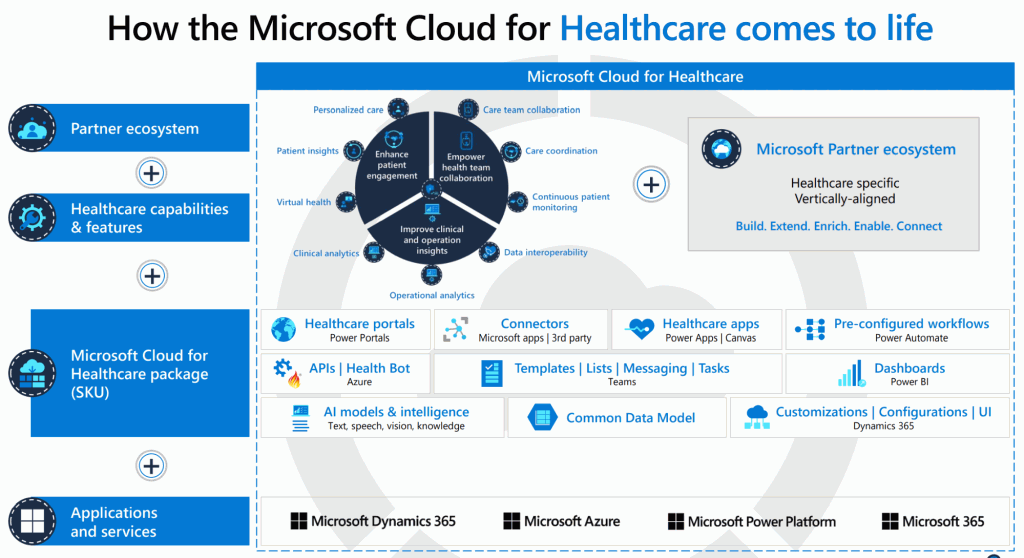
Core Functionalities
MCFH aims to transform and accelerate the new future of healthcare by focusing on a few key components like:
- Boosting patient engagement
- Helping healthcare organizations to collaborate
- Focusing more on clinical data insights
- Giving healthcare organizations a more secure platform
- Building a cohesive healthcare partner ecosystem
MCFH service was built to provide patients with faster and efficacious care, aid collaborations with other healthcare organizations, facilitate patient engagement, optimize informatics and operational insights, provide a more cohesive workflow while maintaining tight security measures. MCFH also enables patients to make their own decisions while delivering secure, personalized experiences.

1. Enhance Patient Engagement
MCFH helps healthcare organizations to engage in more proactive ways with their patients, allows caregivers to improve the efficiency of their workflows, and streamline interactions with patients with more actionable results.
Organizations can use Microsoft Cloud for Healthcare to extend the value of Microsoft Dynamics 365 Marketing, Dynamics 365 Customer Service, and Azure IoT to deploy:
- Consumer-friendly patient experience: Healthcare organizations can create individualized care plans for patients, or groups of patients, allowing providers to publicize relevant content and proactively outreach to patients on any device. They can arrange secure virtual visits, chatbot assessments, and remote health monitoring to create a connected health experience through the Microsoft Healthcare Bot Service.
- Connecting physician and referral management: The pandemic saw patients seeking online tools that allow them to see their healthcare provider without leaving their homes. With MCFH, care teams can easily create referrals, search for providers, and understand physician spend, satisfaction, and enhanced analytics on referral categories.
- Enhanced patient engagement portals: Patients and providers can easily interact through the self-service portal for online appointment bookings, reminders, bill payments, and much more. This also allows providers the ability to engage with patients easily through the device of their choice.
- Intelligent patient outreach: Enables healthcare organizations to design interactive patient journeys to nurture leads, publicize relevant events, and contact patients with preventative and care management programs that help promote better health outcomes. By creating a "360-degree patient view," healthcare organizations can better understand their patients’ needs, take faster decisions, and take action across different teams.
- The Patient Outreach app: Provides a template that leverages the industry measures described by Healthcare Effectiveness Data and Information Set (HEDIS) for patient segmentation and campaign management, helping organizations reach patients with specific conditions in a more targeted manner.
- Continuous patient monitoring through IoT: Generates secure, scalable data ingestion from medical devices to allow care teams to monitor patients in and outside clinical facilities. With real-time insights, care teams can provide timely escalations of care, reduce readmissions, and provide personalized, predictive care.
2. Empower Healthcare Collaboration
Even before the global pandemic, the healthcare industry was witnessing a shift towards team-based care. With MCFH, healthcare organizations can collaborate and share knowledge on a secure platform.
By providing the correct information at the right time to the right people, care teams can make faster decisions, take action more quickly, and manage complex workflow processes more effectively. Microsoft wants to transform patient care beyond the four walls of the hospital room by enabling healthcare organizations to securely monitor data of recovering patients, helping them manage chronic illness, or even supporting patients with disabilities through Microsoft Azure IoT and Artificial Intelligence.
Microsoft has integrated the Teams and Power Apps to create a more cohesive workflow for healthcare organizations. For example, the Bookings app in Teams enables healthcare providers to schedule, manage, and conduct provider-to-patient virtual visits within the app. It can also manage, schedule, and provide patients with virtual visits on the secure Teams collaboration platform. In addition, the app sends patients a customized email that can take them to their virtual appointment on any device. Teams, HIPAA compliant and HITRUST certified, bring together chat, voice, and video meetings and also have the option of video recording and transcription. It also offers secure messaging features, available across devices helping workers to work more efficiently and swiftly without putting in weeks of labor.
Microsoft empowers healthcare organizations to take advantage of the robust ecosystem they are building through EHR and platform integrations, implementation services, and healthcare SaaS offerings.
3. Cloud Built on Interoperability, Security, and Trust
The rise of medical specialization created exponential growth in online patient traffic. This created a massive demand for a platform that was secure and could protect sensitive data. The Microsoft 365 and Microsoft Teams products have been developed to address these issues by allowing for efficient healthcare workflows and a secure platform for connected care coordination. It also aims to simplify data management with a single, consistent solution for protected health information (PHI).
MCFH provides a highly secure data platform Azure FHIR service that allows healthcare workers to ingest and persist data in the FHIR format. As a result, Healthcare organizations that have already adopted the FHIR have been able to collaborate faster while also giving their teams the ability to care for patients with great agility.
Security and compliance are the topmost priority for any healthcare organization. With Microsoft’s cloud service, PHI data can be stored with confidence since Azure security provides a layered, in-depth Defense system aligned to industry compliance standards (GDPR, HITRUST, CCPA, and HIPAA).
4. Improve Clinical and Operational Insights
The healthcare sector has always struggled to effectively use the vast amount of data it creates since most of the data is unstructured and inaccessible to make data-driven decisions. With MCFH, organizations can improve their clinical and operational insights by:
- Gathering data from structured/unstructured sources
- Visualizing trends and insights using Power BI
- Setting up operational tasks based on these insights
- Interpreting structured/unstructured data from disparate systems
- Securely sharing data and insights with different departments
5. Building a Cohesive Partner Ecosystem
If anything, this pandemic has taught us that no business is immune to a crisis, and no organization is fully resilient. However, digitally-enabled healthcare systems can pivot more quickly and meet patients’ needs. A connected health ecosystem is a key to improving health outcomes, reducing costs, thus enabling healthier lives. MCFH is designed to help customers breakthrough friction points on their digital transformation journey.
Pricing
Microsoft Cloud for Healthcare includes:
- Healthcare-specific configurations, connectors, and applications.
- Technical support, including unlimited 24/7 access to technical resources.
- Access to an extensive, experienced healthcare partner ecosystem.
Microsoft Cloud for Healthcare is sold as an add-on SKU, added to existing or new Volume Licensing Enterprise Agreements (EA). Microsoft Cloud for Healthcare is generally available in US-English, with additional languages coming later in 2021.
Partner Play
For the last several years, Microsoft has worked with leading Independent Software Vendors (ISV) and System Integrator (SI) partners to help innovate the Cloud.
These partners are now ready to evaluate, extend, and build innovative solutions for healthcare organizations that need to create more responsive, connected, and meaningful engagement with their patients, care teams, and communities. Microsoft has worked closely with the leading health systems providers, from organizations like Accenture/Avanade, Adaptive Biotechnologies, Allscripts, DXC Technology, Innovaccer, KPMG, and Nuance to co-develop new solutions with leaders in their respective sectors like Humana, Providence, Novartis, and Walgreens Boots Alliance.
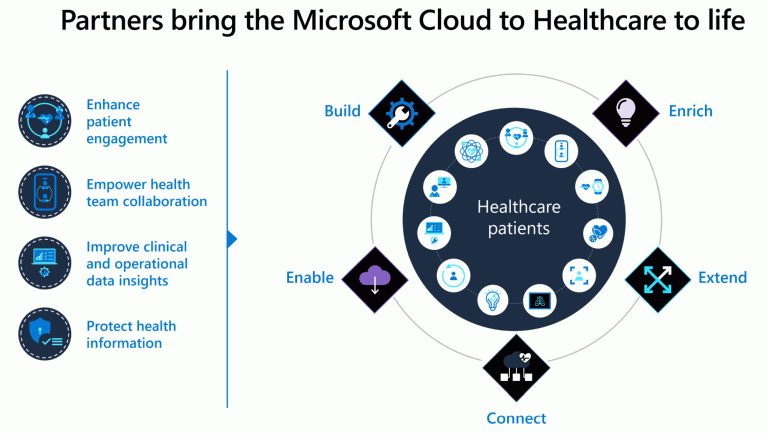
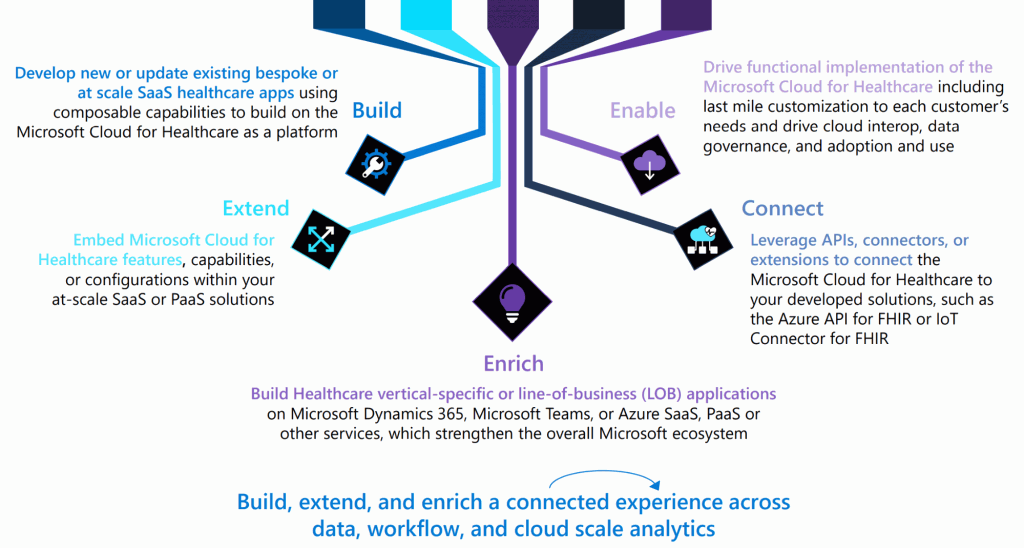
How System Integrator Needs To Change
Healthcare organizations need System Integration (SI) to improve the productivity and quality of their operations and to faster time to market for future healthcare services. The goal is to get the organization’s various IT systems to talk to each other through the integration, speed up information flows and reduce operational costs. In addition, SI would need to play a vital role in the cloud-first mindset journey empowered by Healthcare Industry Cloud capabilities.
Suggested changes in the SI business model and solution design approach from long drawn custom development to:
- Faster and lean migration to Public Cloud and Distributed Cloud for Cost saving and IT agility
- Outcome-based migration, modernization, and managed services for Cloud Workloads
- Invest in developing Regional Healthcare compliance controls, and associated automation for Security & Compliance as Code bundled with Managed SIEM & SOC solution or complete Managed Cybersecurity Services bundle.
- Avoid Bespoke solutions and adopt Composable Solution architecture based on the foundation provided by Healthcare Cloud Solutions (e.g., MCFH) for innovation in business models, new Healthcare and Patient Care Services, and integrated Process Integration and optimization.
- Accelerated development using Low Code No Code platform, hyper-automation: In addition to providing significant cost savings, these enterprise low-code solutions help streamline, automate, accelerate, and increase the efficiency and performance of the app development process. As a result, enterprises no longer need to utilize only software developers.
- Deliveries aligned to Faster Time to Market and Market Innovation on top of Healthcare Common Data Model: Common Data Model simplifies data management and app development by unifying data into a known form and applying structural and semantic consistency across multiple apps and deployments.
- Bring best of niche industry partner ecosystem relationships and expertise for Composable Solutions: This concept enables computing, storage, and networking devices to be pooled and used as needed without requiring physical configuration, opening the door to a nimbler environment, in which resources are not only accessed quickly but also used precisely.
- Bring in Cross-Industry integration, learnings and develop new decentralized computing-enabled business models and solutions.
Summary
Innovation and problem solving don’t happen in a vacuum. Every person in the healthcare business plays a role in moving the organization forward with the right set of digital tools. This is just the beginning for Microsoft Cloud for Healthcare.
Microsoft Cloud for Healthcare (MCFH) is more than an enabling technology platform. It is a platform that helps clients transform their operations by making them more efficient and effective. New solutions can be developed and brought to market much more quickly due to this technology’s flexibility and power. Moreover, it empowers organizations to approach problems in a new and more effective way.
Microsoft will continue to update and expand its cloud capabilities. This means ensuring a better patient experience and patient safety. Microsoft promises to deliver better experiences, better insights, and better care.
Published at DZone with permission of Gaurav Agarwaal. See the original article here.
Opinions expressed by DZone contributors are their own.

Comments